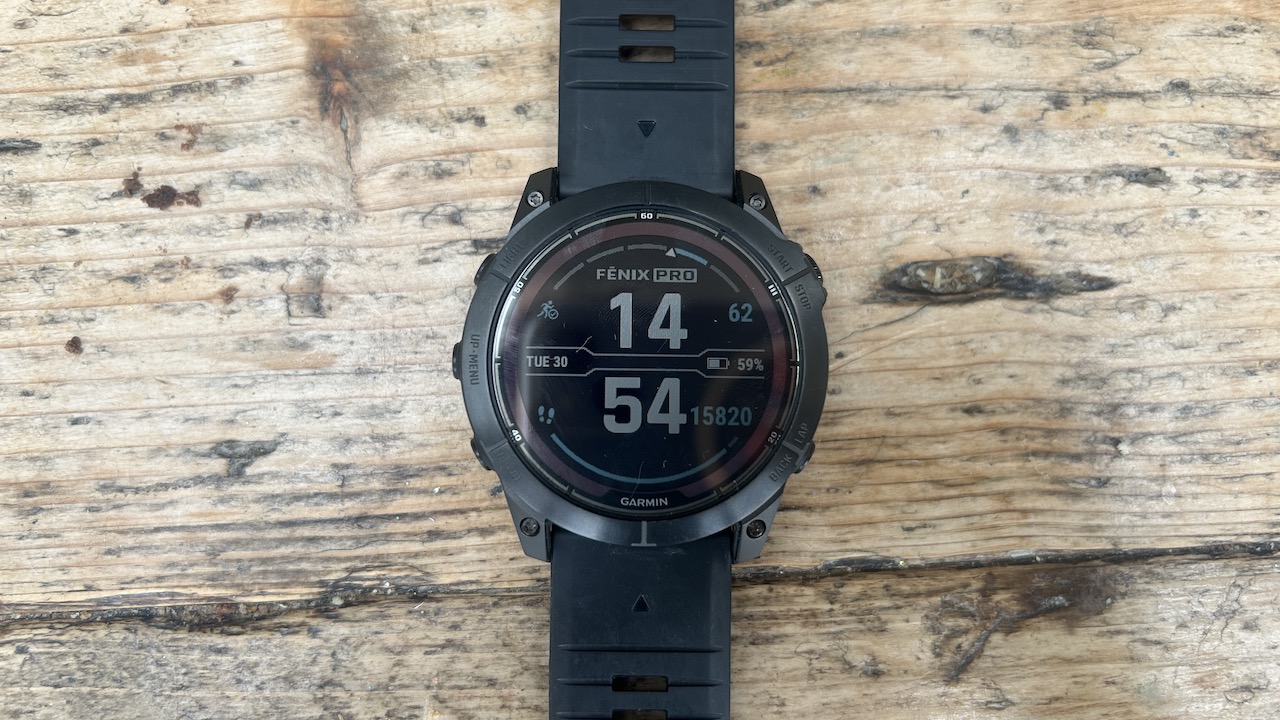Our Verdict
The Garmin Fenix 7 Pro is a modest update on the standard Fenix 7 range, standardizing features like solar charging, flashlights and multi-band GPS, while introducing a new heart rate sensor. If you’re coming from the Fenix 6 or earlier it will feel like a leap forward. There’s no doubt the Fenix 7 Pro is one of the best sports watches available, but if you have a Fenix 7 there’s little need to upgrade.
For
- Flashlight on every version
- Improved HR tracking
- Multi-band GPS as standard
Against
- Software updates coming to Fenix 7
- No cheaper non-Solar options
- New HR sensor not infallible
You can trust Coach
It’s getting crowded at the top of Garmin’s range, with the Garmin Fenix 7 Pro and Garmin Epix Pro ranges joining the existing Fenix 7 and Epix 2, along with the Garmin Enduro 2 and Garmin Forerunner 965. All of the above are among the best sports watches available, offering an array of features to support and enhance your training.
For its part, the Garmin Fenix 7 Pro line-up delivers minor but useful hardware updates on the Fenix 7 range, along with new software features that will apply to the older Fenix 7 watches. It’s an update Fenix 7 owners can skip, though it continues to improve the line and ensures Garmin stays clear of the competition.
Garmin Fenix 7 Pro Review: Price And Availability
The Garmin Fenix 7 Pro launched on 31st May 2023, along with the Garmin Epix 2 Pro. There are three sizes in the range and in each size you choose between standard and sapphire models. The standard model costs from $799.99 in the US and £749.99 in the UK, while the sapphire models can cost as much as $999.99/£1,099.99.
December 1, 2023: There are now regular sales and deals featuring the Garmin Fenix 7 Pro. In our extensive coverage of the best Black Friday Garmin deals in 2023 the best prices we tracked were $599.99 and £628.34.
Design And Key Hardware
There are two significant changes to the hardware of the Fenix 7 Pro when compared with the Fenix 7. The first is the addition of a heart rate monitor, across the range. The second is that all three sizes have a built-in flashlight, whereas only the Fenix 7X has it in the older range. The flashlight is a helpful addition. I mainly use it to negotiate my way around an untidy house at night to respond to crying children, though others may have more adventurous uses in mind.
All the Pro watches have solar charging, which was available only on some models of the Fenix 7. Garmin says that the memory-in-pixel screens on the Pro watches have been improved to be clearer than those on the Fenix 7 range, but I didn’t notice any difference in my testing. The screens are easy to read in all conditions, but less bright than an AMOLED display when inside or under cloud cover. Otherwise, the new watches look identical to the old ones.
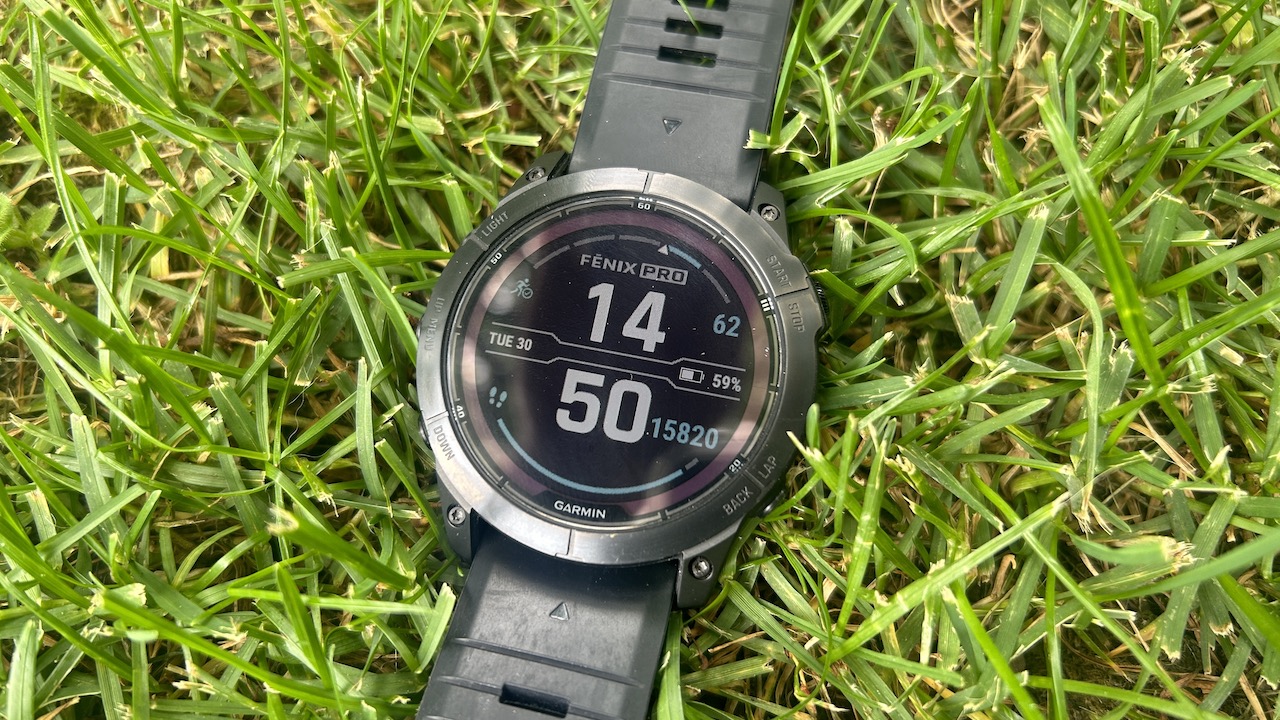
The Fenix 7S Pro has a 1.2in screen, the Fenix 7 Pro has a 1.3in screen, and the Fenix 7X Pro has a 1.4in screen; they ship with a silicone strap, though there are other materials available in the accessories range, including nylon straps that make the watches feel lighter on the wrist. That’s handy because they are chunky watches, especially the steel models (63g/2.2oz, 79g/2.7oz or 96g/3.3oz with silicone strap), which weigh a few grams more than the titanium models (58g/2oz, 73g/2.5oz or 89g/3.1oz with silicone strap).
Battery life rises through the range. With the Garmin Epix Pro watches offering the same features, as well as a bright AMOLED display, battery life is the reason to go for a Fenix 7 Pro watch instead—which is probably why Garmin has made solar panels standard across the range.
Sign up for workout ideas, training advice, reviews of the latest gear and more.
There is no upgrade in battery life compared with the Fenix 7 range though, with the Pro models offering the same juice as their solar equivalents of the older watch. All the watches have multi-band GPS tracking, which is Garmin’s most accurate mode—and something that is available only on sapphire models in the Fenix 7 range.
| Header Cell - Column 0 | Garmin Fenix 7S Pro | Garmin Fenix 7 Pro | Garmin Fenix 7X Pro |
|---|---|---|---|
| Smartwatch mode | 11 days/14 days solar | 18 days/22 days solar | 28 days/37 days solar |
| GPS-only | 37 hours/46 hours solar | 57 hours/73 hours solar | 89 hours/122 hours solar |
| All-systems GPS | 26 hours/30 hours solar | 40 hours/48 hours solar | 63 hours/77 hours solar |
| Multi-band GPS | 15 hours/16 hours solar | 23 hours/26 hours solar | 38 hours/41 hours solar |
| All-systems GPS plus music | 7 hours | 10 hours | 16 hours |
All the watches have a 10ATM waterproof rating, can connect to external sensors via Bluetooth and ANT+, and can connect to Wi-Fi. Other sensors include a compass, barometric altimeter and pulse oximeter.
How I Tested This Watch
I tested the Garmin Fenix 7X Pro for three weeks, mostly alongside the Garmin Epix Pro watch. I’ve used the watch to track more than 100 miles of running, as well as bike rides and indoor strength and yoga sessions. It has also tracked my sleep and daily activity. I’ve tested every generation of the Fenix since the Fenix 5 Plus, along with almost all of Garmin’s other sports watches.
HR And GPS Accuracy
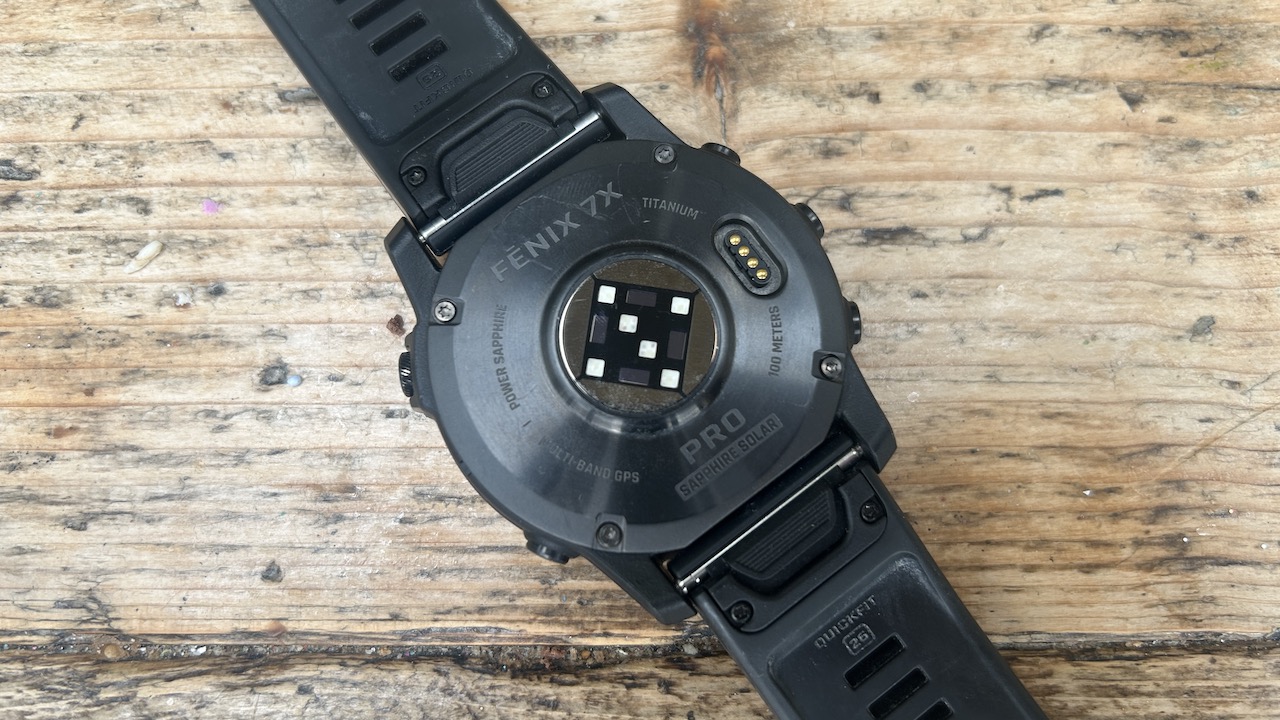
The new heart rate monitor is what sets the Pro apart. I’ve yet to find an optical heart rate monitor on a watch that I trust to track my training accurately, and instead use a chest strap heart rate monitor. The Fenix 7 Pro’s heart rate tracking won’t change that, but it is accurate for an optical wrist-based monitor.
Across my runs and other workouts there were never glaring, or lengthy, errors when compared with the reading from a chest strap. By and large, I could use the Fenix 7X Pro without a strap to guide training. However, there are still mistakes—such as spikes in heart rate at the start of workouts and lag in tracking the rise and fall of heart rate during interval sessions.
Occasionally, the watch’s heart rate reading would spike too high during an interval, and it once missed an interval entirely. These aren’t huge issues, but they affect the training analysis you get from the watch.
If you’re already happy just using your watch’s optical heart rate to track sessions you will probably notice and enjoy the improvement in accuracy you get from the Fenix 7 Pro, but if you’re someone who uses a chest strap for reliable readings you’re unlikely to be convinced to jettison it.
The GPS accuracy from the Fenix 7 Pro is excellent, and matches up with other top Garmins in producing the most accurate tracks you can get from any brand when using the multi-band mode.
Hill Score And Endurance Score
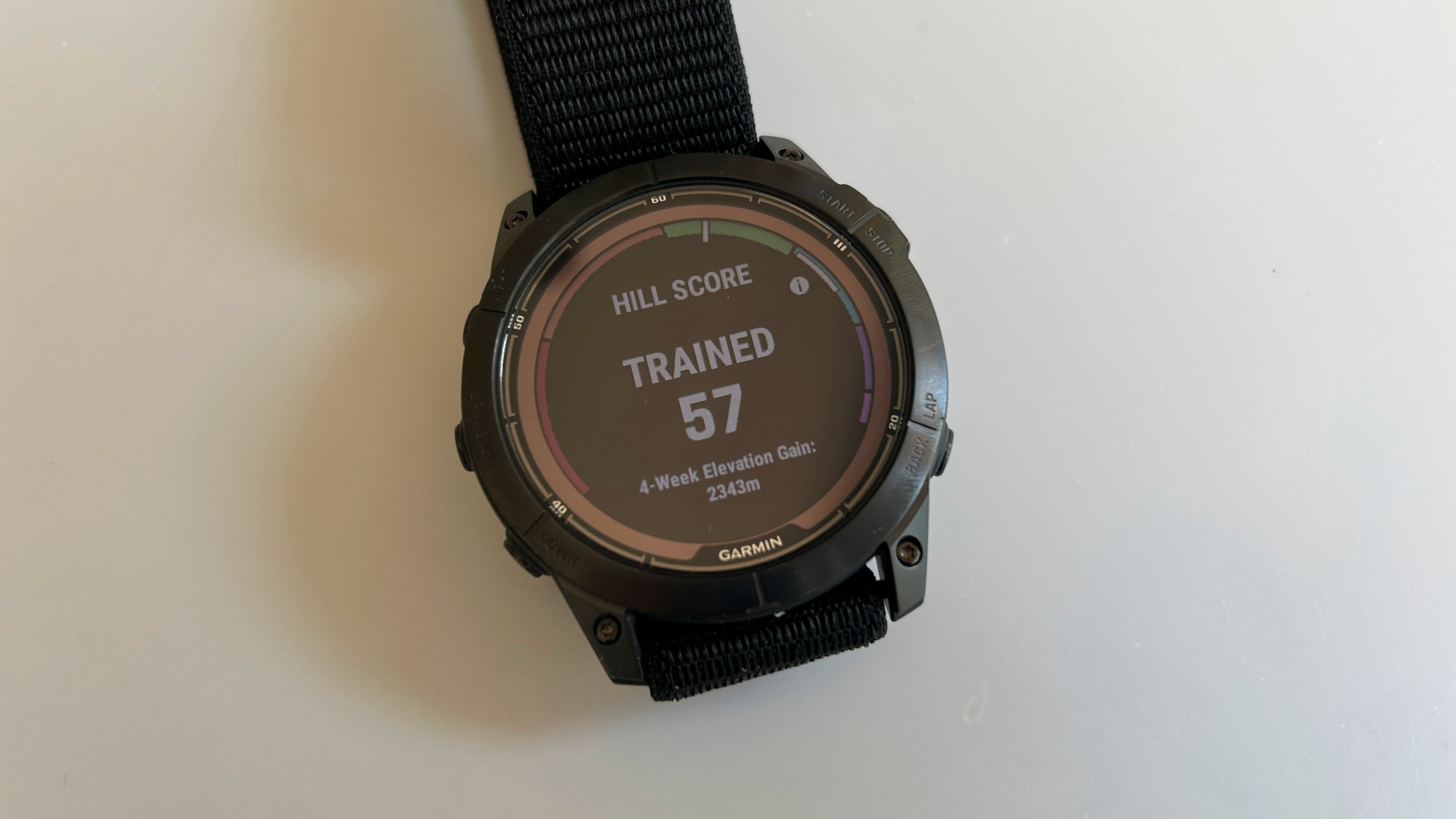
The additions to the training analysis on the Fenix 7 Pro range are hill score and endurance score (which are rolling out to the Fenix 7, Epix 2, Forerunner 955 and Forerunner 965 later this year). Hill score is for runners, and rates your ability on hills out of 100 based on your endurance and strength on hills, plus your VO2 max. Endurance score is for all sports, and provides a rating of your ability to sustain long efforts, with no maximum score.
The endurance score matched well with the other training analysis on the watch. I have an endurance score of 9,628, which is rated as elite. That’s a pleasing thing to read, but I’m not sure it adds much to the other assessments of my fitness on the watch, such as VO2 max.
My hill score rating is 62/100, which is classed as “trained”, with my hill strength and hill endurance rated as moderate. I’m mostly a road runner but have done more trail running on undulating ground while testing the watch, as well as one hill session, which means my hill score rating has increased.
The score can be a useful target for improvement if you are working on doing more hills, and it is a different way to rate fitness from things like VO2 max and endurance score. My score feels about right—I’m in good shape for something like a road marathon but wouldn’t consider myself a strong hill runner. If you’re a dedicated trail runner who feels underappreciated by ratings like race predictions on the watch, hill score may suit you better.
Battery Life
The battery life on the Fenix 7X Pro matched my experience of testing the Fenix 7X—which is to say it’s very good. When using multi-band GPS tracking to record six or seven hours of outdoor activity a week, with notifications enabled and the backlight brightness on max most of the time, the watch comfortably lasted three weeks.
I have engaged a sleep mode that helps reduce battery drain at night—and it is summer, which has resulted in assistance from the solar panels. However, I wouldn’t expect much from solar charging unless you are outdoors for several hours a day with the watch facing the sun.
Sports Tracking And Training Analysis
The sports tracking on the Fenix 7 Pro is as good as you get on any watch: Highly detailed and easy to use, it can be customized to display the stats you want to see for your main sports. It’s also backed up by training analysis features like training readiness and suggested workouts each day.
In my opinion, training readiness is the stand-out analysis available on any sports watch. It gives a color-coded rating of your readiness to workout at any time, based on factors like recent training and sleep quality. It’s an easy top-line stat to have available to guide your training, and if you want more detail there’s plenty to dive into on the watch and in the Garmin Connect app.
Garmin has introduced dozens of new sports modes with the Fenix 7 Pro, including soccer, basketball and horseback riding. None of these are useful to me, but it’s never a bad thing to have more sports modes on a watch.
Maps And Navigation
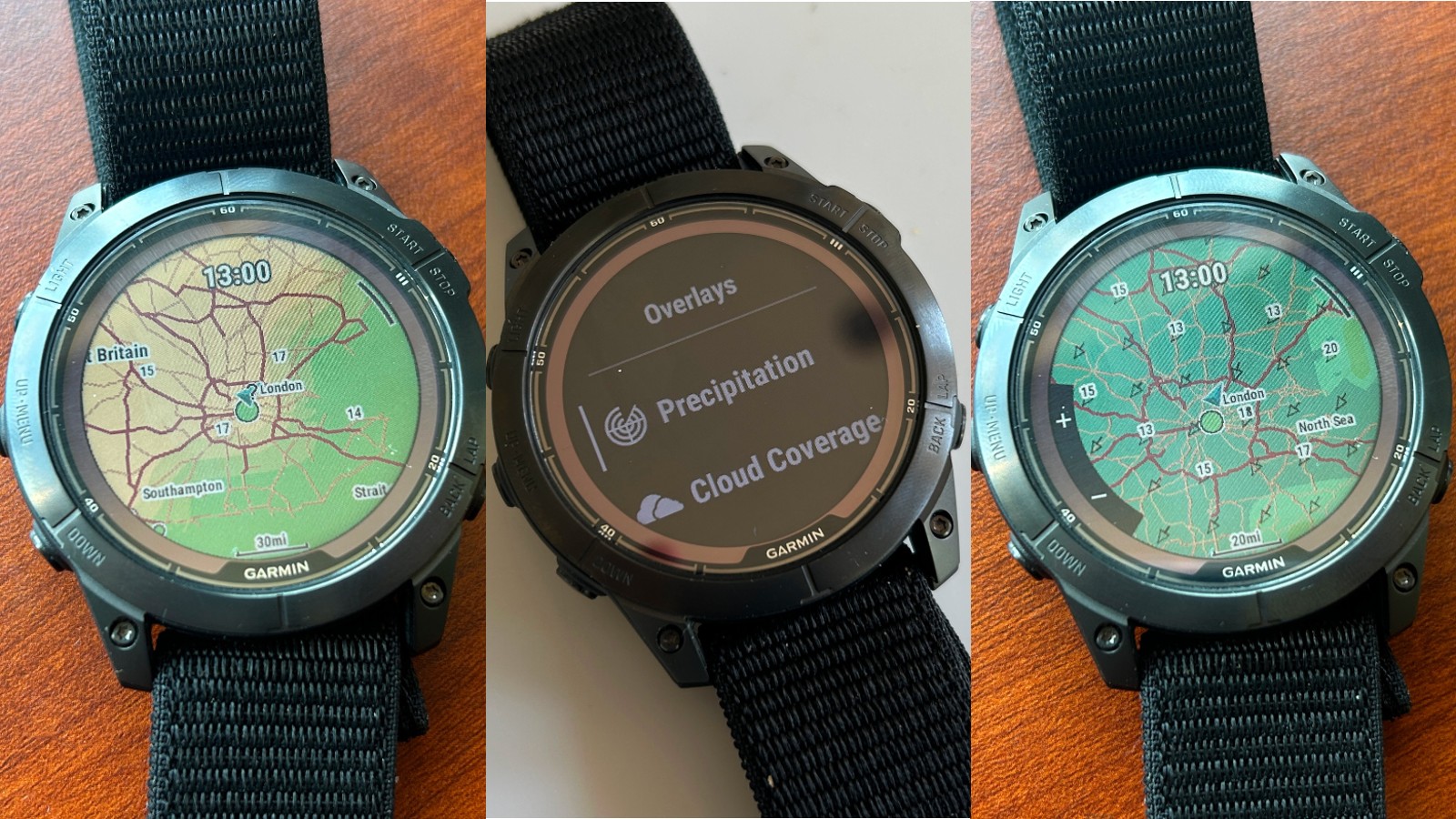
Garmin’s mapping features are the best available on any sports watch, with detailed color-coded maps stored on the Fenix 7 Pro range to make it easy to create routes on the fly or follow pre-planned courses synced from the Garmin Connect app with turn-by-turn directions.
Another stand-out feature is ClimbPro, which highlights each climb and descent on your route so you can judge your effort on each. I mainly use this to avoid going too hard early on in what turn out to be surprisingly long climbs.
There are new features within Garmin’s maps on the Fenix 7 Pro, including data screen options in sports modes that show the map along with stats. This is either via a split screen with stats on one side and the map on the other or in the new perimeter view, where a thin band around the outside of the maps shows up to six stats.
The perimeter view is best for hiking, since it’s hard to see the stats when running, but I like the split-screen view for following routes while keeping an eye on my stats.
Other additions to the maps include a weather overlay you can use in the weather widget on the watch. There are four overlay options—temperature, precipitation, wind and cloud cover—and they show conditions in your area over the coming hours. It can be useful, though the overlays are not available on the map screen within activities, which is probably the only time I’d use them to see if there was rain coming up without having to leave my route page.
Smart Features
The Garmin Fenix 7 Pro is not a full smartwatch because it lacks cellular connectivity and a proper app store—though the Connect IQ store is useful for watch faces, third-party data fields, and the Parkrun barcode app. The watch does have several useful smart features, though.
Music is the best of them. The Fenix 7 Pro provides 32GB of storage and while maps and other features use a lot of this, you can still put plenty of music on the watch. This is done either via direct transfer or by linking it to a streaming service to sync playlists across for offline playback—Spotify, Deezer and Amazon Music premium accounts are all supported.
An important smart feature is NFC payments through Garmin Pay, which does not support a lot of UK high-street banks but is better supported in the US. The watch also mirrors phone notifications and calendar appointments, and has a great weather widget.
Activity And Sleep Tracking
All the usual stats are tracked by the Fenix 7 Pro each day, including steps, active calories burned and floors climbed. It also monitors your heart rate variability each night to see if you are within your normal range, and it adds your general activity levels into its estimated recovery time for training.
For the sport-focused, the training readiness feature is the best use of the activity and sleep tracking, since it feeds into that performance-focused metric. It’s worth keeping tabs on your sleep each day because the tracking is a little generous at times, logging periods as light sleep when you are awake but just lying still.
Garmin watches have improved on this front over the last couple of years and the sleep tracking is good enough to be useful after being put into the readiness stat, though the Fenix 7 Pro is not as accurate in spotting time awake as devices from Fitbit and Polar in particular.
Is The Garmin Fenix 7 Pro Worth It?
The Garmin Fenix 7 Pro is clearly the best Fenix available, but if you already have the Fenix 7 there is no need to upgrade unless you really want that flashlight. All the software features being rolled back to older watches is welcome, especially because it’s not something Garmin always does, and it means the Fenix 7 is still worth looking at if you are buying a watch this year and don’t need the solar panels, or the improved heart rate monitor. You can find a more in-depth rundown with my Garmin Fenix 7 Pro Vs Garmin Fenix 7 guide.
If you want an AMOLED display then the Garmin Epix Pro offers the same features as the Fenix 7 Pro, including the flashlights. Again, you can get stuck into the details with my Garmin Fenix 7 Pro Vs Garmin Epix Pro guide.
The Garmin Forerunner 965 also has an excellent AMOLED display in a smaller, lighter watch that’s also cheaper and remains, for my money, the best-value option among Garmin’s top watches.
Outside of Garmin, the Suunto Vertical is another long-lasting watch that offers maps and solar-charging. The user experience is not as slick with the Suunto, though, and it lacks many features you get with the Fenix 7 Pro such as ClimbPro, music storage and training readiness.
The same is true of the Coros Vertix 2, which has most of the main features you get on the Fenix 7 Pro, but it’s nowhere near as polished and useful. The maps and music features on the Coros fall well short of what you get from the Fenix, for example, and its GPS accuracy is not as good.

Nick Harris-Fry is a journalist who has been covering health and fitness since 2015. Nick is an avid runner, covering 70-110km a week, which gives him ample opportunity to test a wide range of running shoes and running gear. He is also the chief tester for fitness trackers and running watches, treadmills and exercise bikes, and workout headphones.
